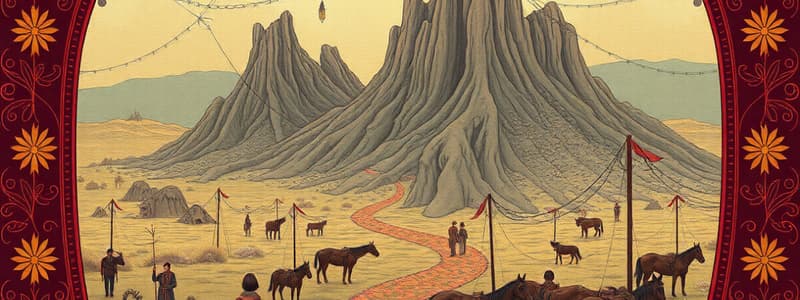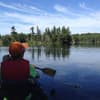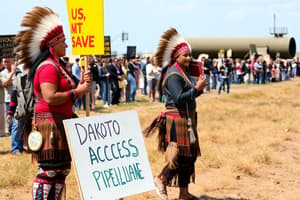Podcast
Questions and Answers
Match the individual/group with their corresponding action or stance regarding the Dakota Access Pipeline:
Match the individual/group with their corresponding action or stance regarding the Dakota Access Pipeline:
Standing Rock Sioux Chairman Dave Archambault = Requested the camp be vacated due to winter conditions Individuals in camps = Planned to set up army tents IIYC = Vowed to continue the fight against the pipeline Donald Trump = Expedited the Army Corps of Engineers' review and approval of the pipeline
Match the group with their action relating to authorities present:
Match the group with their action relating to authorities present:
Youth Council = Donated to the police officers near the barricades Individuals in camps = Created barricades Army Corps of Engineers = Were ordered to expedite the the review and approval of the pipeline Rick Perry = Selected to head the Department of Energy
Match the concerns with their corresponding context within the Dakota Access Pipeline situation:
Match the concerns with their corresponding context within the Dakota Access Pipeline situation:
New American President = Future pipelines across indigenous territories Eviction notice = Individuals worried about their safety Continued protests = People will see this as a show and return to their lives afterwards Political Contributions = Donald Trumps campaign
Match the person with their organization, and the amount that organization donated to Donald Trump's presidential campaign.
Match the person with their organization, and the amount that organization donated to Donald Trump's presidential campaign.
Match the event with the date it occurred:
Match the event with the date it occurred:
Match the following figures or groups with their roles or actions in the Standing Rock protests:
Match the following figures or groups with their roles or actions in the Standing Rock protests:
Match each entity with their role in the Dakota Access Pipeline (DAPL) project:
Match each entity with their role in the Dakota Access Pipeline (DAPL) project:
Match the historical events with their significance to the Standing Rock Sioux:
Match the historical events with their significance to the Standing Rock Sioux:
Match the concerns of the Standing Rock protesters with the potential impacts of the Dakota Access Pipeline:
Match the concerns of the Standing Rock protesters with the potential impacts of the Dakota Access Pipeline:
Match the following terms with their meanings or significance in the context of the Standing Rock protests:
Match the following terms with their meanings or significance in the context of the Standing Rock protests:
Match each action with its purpose during the Standing Rock movement:
Match each action with its purpose during the Standing Rock movement:
Match the figures with their involvement in Historical Trauma of the Standing Rock Sioux:
Match the figures with their involvement in Historical Trauma of the Standing Rock Sioux:
Match the following types of support provided by the Youth Council with their key aspects:
Match the following types of support provided by the Youth Council with their key aspects:
Match the following entities with their roles during the Dakota Access Pipeline protests:
Match the following entities with their roles during the Dakota Access Pipeline protests:
Match the locations with their significance during the Dakota Access Pipeline protests:
Match the locations with their significance during the Dakota Access Pipeline protests:
Match the individuals with their involvement in the Dakota Access Pipeline protests:
Match the individuals with their involvement in the Dakota Access Pipeline protests:
Match the following protest actions with their descriptions:
Match the following protest actions with their descriptions:
Match the services provided at the Oceti Sakowin Camp with their purpose:
Match the services provided at the Oceti Sakowin Camp with their purpose:
Match the following descriptions with the corresponding groups involved in the Dakota Access Pipeline protests:
Match the following descriptions with the corresponding groups involved in the Dakota Access Pipeline protests:
Match the claims made by Energy Transfer Partners with the contradictory evidence:
Match the claims made by Energy Transfer Partners with the contradictory evidence:
Match the actions taken by law enforcement with the criticisms they faced:
Match the actions taken by law enforcement with the criticisms they faced:
Match the conditions reported by those arrested at Sacred Grounds Camp with their description:
Match the conditions reported by those arrested at Sacred Grounds Camp with their description:
Match the following dates with the events that occurred during the Dakota Access Pipeline protests:
Match the following dates with the events that occurred during the Dakota Access Pipeline protests:
Match each term related to the Dakota Access Pipeline protests with its definition:
Match each term related to the Dakota Access Pipeline protests with its definition:
Match each legal action with its initiating party during the Dakota Access Pipeline conflict:
Match each legal action with its initiating party during the Dakota Access Pipeline conflict:
Match the descriptions with the corresponding types of injuries sustained during the Dakota Access Pipeline protests:
Match the descriptions with the corresponding types of injuries sustained during the Dakota Access Pipeline protests:
Match the motivations of key participants with their respective actions during the Dakota Access Pipeline:
Match the motivations of key participants with their respective actions during the Dakota Access Pipeline:
Match the effects on the Standing Rock Sioux with their descriptions:
Match the effects on the Standing Rock Sioux with their descriptions:
Flashcards
Standing Rock Protests
Standing Rock Protests
Protests against the Dakota Access Pipeline construction on Indigenous ancestral lands.
DAPL Concerns
DAPL Concerns
Potential contamination of drinking water and destruction of sacred sites.
IIYC
IIYC
An international Indigenous youth group that initiated the Standing Rock movement.
NoDAPL Runners
NoDAPL Runners
Signup and view all the flashcards
7th Generation
7th Generation
Signup and view all the flashcards
Historical Trauma
Historical Trauma
Signup and view all the flashcards
Sioux Westward Migration
Sioux Westward Migration
Signup and view all the flashcards
Fort Laramie Treaty (1851)
Fort Laramie Treaty (1851)
Signup and view all the flashcards
Dave Archambault
Dave Archambault
Signup and view all the flashcards
Energy Transfer Partners CEO
Energy Transfer Partners CEO
Signup and view all the flashcards
Rick Perry
Rick Perry
Signup and view all the flashcards
Trump's Pipeline Memorandum
Trump's Pipeline Memorandum
Signup and view all the flashcards
Sue's grievances
Sue's grievances
Signup and view all the flashcards
Army Corps of Engineers' claim
Army Corps of Engineers' claim
Signup and view all the flashcards
Oceti Sakowin Camp
Oceti Sakowin Camp
Signup and view all the flashcards
Indigenous People's Power Project
Indigenous People's Power Project
Signup and view all the flashcards
Protectors, Not Protesters
Protectors, Not Protesters
Signup and view all the flashcards
Sept 3, 2016 Confrontation
Sept 3, 2016 Confrontation
Signup and view all the flashcards
Dashepae
Dashepae
Signup and view all the flashcards
Security dog licensing
Security dog licensing
Signup and view all the flashcards
Escalation of Violence at DAPL
Escalation of Violence at DAPL
Signup and view all the flashcards
Sacred Grounds Camp Charges
Sacred Grounds Camp Charges
Signup and view all the flashcards
Detention Conditions at DAPL
Detention Conditions at DAPL
Signup and view all the flashcards
Law enforcement's priority
Law enforcement's priority
Signup and view all the flashcards
Forgiveness March
Forgiveness March
Signup and view all the flashcards
Prayer March
Prayer March
Signup and view all the flashcards
Backwater Bridge Incident
Backwater Bridge Incident
Signup and view all the flashcards
Study Notes
Standing Rock Protests
- Indigenous people are protesting the Dakota Access Pipeline construction on their ancestral lands.
- Burial sites are located on the construction site.
- Protesters fear destruction of sacred sites and water contamination.
- Protesters use prayer and peaceful demonstration to prevent pipeline construction.
- Ancestral remains cannot rest in peace due to the pipeline construction.
- The youth council emphasizes peaceful protests.
- The Standing Rock Sioux and allies have camped on the Cannonball River banks for months.
- The goal is to halt the $3.7 billion Dakota Access Pipeline.
- The pipeline is slated to carry crude oil from North Dakota to Southern Illinois.
- The route is within 1,500 feet of the Standing Rock Reservation.
- The tribe fears the pipeline will contaminate drinking water and destroy sacred sites.
- The International Indigenous Youth Council (IIYC) began the movement in Standing Rock.
- The youth believe this movement will continue until they win.
- The youth started the movement with Jasin Charger and the NoDAPL Runners.
- They ran from Cannon Ball, North Dakota, to Washington D.C., and Omaha to raise awareness.
- The run became a spiritual movement with unexpected support.
- The youth Council started with five people and grew to a core of 20, with 30-50 attending meetings.
- The youth council provides a family-like support system.
- Indigenous children were historically forced to assimilate, losing their culture and language.
- They are now reclaiming their identity and leadership.
- Some members come from a lineage of American Indian Movement leaders and land/water protectors
- The Seventh Generation is reclaiming their voices and opposing broken treaties.
Historical Context
- Understanding the Standing Rock situation requires understanding centuries of historical trauma
- The Standing Rock Sioux ancestors originally lived near the Great Lakes.
- White fur traders and intertribal competition pushed them westward onto the Great Plains by the 17th century.
- The 1848 California gold discovery brought white fortune seekers through Sue territory and set off conflicts.
- This led to the Fort Laramie Treaty of 1851.
- The Sue ceded land east of the Missouri River in exchange for lands extending from North Dakota to Southern Nebraska.
- The federal government failed to prevent white settlers from encroaching on Sue lands.
- Subsequent treaties and congressional acts resulted in the Sue losing most of their originally promised land.
- By the late 19th century, the Sue experienced abuse in assimilation schools, the outlawing of their religion, dependence on government aid, and massacres.
- Tribal lands were illegally taken and they demand respect for their lands, people, and rights today.
- Energy Transfer Partners representatives claim the pipeline is safer than truck or rail transport.
- They insist it poses no threat to drinking water or sacred sites.
- The CEO wished the Standing Rock Sioux had engaged in discussions earlier to change the route, but it is now "too late".
Contradictory Evidence
- A 2014 recording reveals Energy Transfer Partners knew of the tribe's opposition from the start.
- The tribe opposed any pipeline within their treaty boundary.
- The chairman stated their commitment to protecting water, sacred sites, sovereignty, and future generations.
- Three federal agencies urged the Army Corps of Engineers to consult with the tribe.
- On July 25, 2016, the Army Corps issued the environmental assessment needed to cross the Missouri River.
- They claimed they had adequately consulted with the tribe.
- The tribe sued the Army Corps for not properly consulting them a month later.
- Energy Transfer sued the tribe for blocking construction 11 days after that.
Protest Camp and Support
- Protests started small in spring 2016 and grew rapidly to thousands.
- Winona LaDuke established the first kitchen at the Oceti Sakowin Camp.
- The various tribes established kitchens for their people.
- The Camp offered services like art supplies, legal aid, a donation center, and 24/7 medical care.
- The Indigenous People's Power Project camp provided training sessions.
Action Principles Developed with Standing Rock Sioux Leadership
- Protectors, not protesters, aim to train people for safety and effectiveness.
- Encourages awareness of risks and willingness to defend others nonviolently.
- Nonviolence is a core aspect; ceremony and spiritual guidance emphasize peace and prayer.
- The youth council acts as de-escalators, reminding people to stay in prayer.
- The Seventh Generation seeks to ignite a flame, starting unity and strength for future generations, with individuals willing to risk their lives for the water and way of life.
September 3, 2016: Confrontation at Sacred Sites
- Dakota Access Pipeline construction crews began bulldozing sacred sites identified by the tribe.
- Hundreds confronted construction workers, including Dashepae, an International Indigenous Youth Council (IIYC) member.
- Dashepae was bitten on her right breast by a security dog after trying to calm it, resulting in significant bleeding.
Accusations and Investigations
- Authorities claimed the protests against the pipeline were not peaceful and needed to end through court agreements with tribal leadership.
- Tribal officials reported twelve people were bitten by security dogs.
- A sheriff's office investigation revealed the dog handlers lacked proper licensing.
Escalation of Violence
- Protesters faced rubber bullets, mace, pepper spray, and smoke canisters for standing on sacred land.
- October 22: Protesters praying in solidarity were surrounded by riot police and armored vehicles.
- Lauren was struck multiple times on the head with a baton by a National Guard member while trying to help a child leave the scene.
- Lauren sustained probable small fractures in her wrist.
- Morton County Sheriff's Office denied Lauren's story.
Mass Arrests and Clearing of Sacred Grounds
- October 22 marked the first mass arrests, with over 140 people arrested including several journalists.
- The October 27 clearing of the newly established Winter Camp, "Sacred Grounds," led to more arrests.
- Police used sound cannons, mace, and batons during the clearing.
- An officer twisted Lauren's injured wrist while arresting her.
- Those arrested were unarmed and peaceful.
- After arrests, bulldozers moved over burial sites while individuals were restrained.
Charges and Detention Conditions
- Nearly all those arrested at Sacred Grounds Camp were charged with felony conspiracy to endanger by fire or explosion, later dropped by a judge.
- Detainees were held in chain-link "dog kennels" in a parking garage, exposed to cold temperatures.
- Numbers were written on the arms of those arrested for identification, considered offensive.
Law Enforcement Perspective
- Morton County Sheriff Kyle Kirchmeier stated that the protests were straining his officers.
- Maintaining public safety was the sheriff's priority.
- Law enforcement claimed aggression only occurred when protesters attacked them.
Forgiveness March
- Organized to restore harmony after confrontations at the sacred grounds camp.
- Participants marched to the police station to connect with officers on a human level, emphasizing they were not against the police but the pipeline.
- During the march, participants prayed with the officers, asking for mutual forgiveness.
Prayer March
- Another action led by the IIYC, a silent march to show discipline and humility, remembering the reason for the protest.
- Terrell, representing the IIYC, offered water used in ceremony to police at the barricade.
November 20th Incident
- Demonstrators attempted to remove burnt-out vehicles from the Backwater Bridge, leading to a clash with police.
- Police sprayed protesters with high-pressure hoses, tear gas, rubber bullets, and sandbags.
- The Standing Rock Medic and Healing Council reported over 300 injuries, with 26 hospitalizations.
Eviction Notice and Winter Camp
- The Army Corps of Engineers issued an eviction notice for December 5, 2016, declaring the land no longer open to the public.
- The governor and Morton County Sheriff's Department warned of fines for supplying the camp.
Community Support and Defiance
- Despite the eviction notice, individuals were planning to set up army tents for paranoid individuals worried about there safety.
- The youth council was to providing donations to the police officers working near the barricades, even if the police were to cut off access to camp.
Halting of the Dakota Access Pipeline
- December 4, 2016, the Army Corps of Engineers announced it would not approve the easement needed, considering alternative routes and a full environmental impact statement.
- Dave Archambault, the chairman of the Standing Rock Sioux pleaded for people to leave the camps because of brutal winter storm conditions.
Ongoing Concerns and Future Challenges
- The IIYC vowed to continue the fight, seeing it as far from over.
- Concerns were rising toward the the new American president and future pipelines across indigenous territories.
Political and Financial Interests
- Donald Trump's presidential campaign received over $100,000 from the CEO of Energy Transfer Partners, with Trump holding significant investments in the companies.
- Rick Perry, previously on the Energy Transfer Partners board was selected to head the Department of Energy.
Trump's Actions
- Less than a week after taking office, President Trump signed a memorandum to expedite the Army Corps of Engineers' review and approval of the pipeline.
Call to Continued Vigilance
- There was deep concerns that people will just see this protest as a music festival, or show and will return to their lives afterwards.
- The importance of indigenous people to unify and make changes to the world was encouraged.
Studying That Suits You
Use AI to generate personalized quizzes and flashcards to suit your learning preferences.





